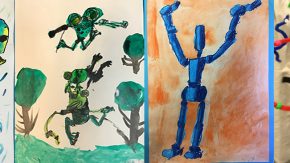Archetypal Learning Spaces in the Digital Age
After reading an article put in front of me early this month I can’t stop thinking about our learning spaces and the way we learn. The article was about ‘Archetypal Learning Spaces’ and how these are now evolving in the digital word.
The archetypal learning theory focuses on looking at ways we have learnt for thousands of years. Traditionally we would learn around a campfire. This was a place for telling stories and listening to times gone by. One person would be the focus and all of the audience would listen in to gain greater understanding of something or just simply to be entertained. The second place that we would learn in was the watering hole. Civilisations would have made the trip to the watering hole everyday to collect water. Here they would have spoken to known people from other tribes, shared information and learnt of different ongoings. Thirdly, we observe the cave. Here is a space for individuals to go and think, to ponder and reflect on what have been learnt. This is a place of solitude and a place to get lost in ones own learning journey. Finally they would need to apply all that had been taken in from the learning spaces and apply it to life. Here is a very short snippet taken from ‘Using archetypes to match learning spaces with physical and digital spaces’.
- Campfire: A place ‘where the storyteller … shared wisdom with students who, in their turn, become storytellers to the next generation’.
- Watering hole: A place ‘where we learn from our peers … each participant at the watering hole is both learner and teacher at the same time’.
- Cave: A place where learners ‘isolate themselves from others in order to gain special insights’.
- Life: ‘The application of knowledge … is an essential component of the learning process (because) when we learn something in anticipation of its immediate use, we not only reinforce our understanding, we increase the likelihood that what we have learning will not be readily forgotten’.
In an age where we are interacting online we can observe the same environments opening up. Think of where we head for our modern day campfire. Places such as YouTube, Vimeo, Pod Casts, Audio Books and other online streaming services allow us to access our campfire. We head to the watering hole in the means of discussing information through blogs, forums, messaging services like email, chat services or even social media outlets. The cave is where we head deep into research skills on the Internet and really clarify any uncertainties that we have about burning questions. However, what about life?
Life is done every day in the digital world. It is creating something that hadn’t existed before us. It is making a blog with your thoughts. It’s about making a presentation that informs people about a topic. It is all the creation that we do online and publish to the world.
So this has got me thinking. How can we encourage our students to approach the digital world through the scope of the archetypal learning environment? Easy. We encourage different methods of accessing information. We promote the use of communication between trusted people. We provide strategies and skills around researching and finally allow our students to demonstrate their new knowledge through the production of websites, videos, blogs and the list goes on.
This term at Wyvern we have delved into our cyber campfires, discussed at our cyber watering holes, disappeared into our cyber caves and ultimately shared something with each other that we have learnt and produced.
Mr Tony Cross
eLearning – Wyvern House and Lindfield Preparatory School






